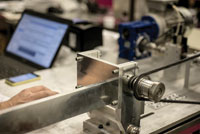
Posted to News on 21st Feb 2016, 00:00
Lubricating the gears of greatness
When metres mean the difference between immortality and anonymity every tiny optimisation is crucial. In the world of professional cycling this could not be more true. Muc-Off set out to create the world’s fastest, most durable bicycle chain lubricants with the ultimate aim of making world records tumble. To achieve this, it required a truly accurate, scientific test bed.

Muc-Off has been in the cycling industry since the early 90s, often solving problems that other companies have not realised exist yet. It provides products for all forms of cycling, and officially partnered with Team Sky in 2014. Marginal gains mean everything, so when Muc-Off claimed it could make Team Sky’s elite cyclists faster by creating the world’s best lubricant, Team Sky challenged the company to prove it.
This challenge drove us to create a test system that could accurately test and measure the performance of our lubricants on professional-grade bicycle chains. We needed a way to prove that our lubricants are the best available and can make the difference between winning and losing. We needed to create a system that we could adjust in many different ways and still provide incredibly accurate test results that are repeatable time and time again.
With buy-in from Team Sky, Muc-Off’s chemical engineers ramped up work on formulating a lubricant that could perform flawlessly while other members of the team set about developing a proving ground for it. With respect to the chain and lubricant, the team developed a test rig that emulated the essential aspects of a bicycle.
The basic rig consisted of a large sprocket at the front called a chain ring, which the crank arms and pedals attach to on an actual bike. It also included a rear cassette on the back, which is the same as the gears that connect to your rear wheel on any bike, and a chain links between these two parts. The rig was made mechanically adjustable to mimic countless different bicycle size and geometry combinations. This flexibility had to be replicated in every other part of the rig as well, including the software, sensors and instrumentation, and the drive for the system.
A dynamometer (dyno) was added to the test system to accurately replicate cyclist inputs to the rig and conversely obtain measurable outputs. In one of the available configurations, this rig consisted of a motor that drives the chain ring like a conventional dyno to analyse torque and speed at both input and output.
Muc-Off reached out to National Instruments for the control and instrumentation platform, built around LabVIEW software and CompactDAQ hardware. The graphical and intuitive way that LabVIEW empowers users to convert logical diagrams into functional code meant the Muc-Off team could learn quickly and convert its ideas of an end product into a reality in the fastest and most simple way possible. LabVIEW gave Muc-Off the ability to switch to a graphical representation of the data in a form that cycling professionals can easily understand, which speeded up development time greatly.
The main objective of the test system is to measure efficiency for analysis and comparison. The efficiency of the chain and lubrication are calculated using several Muc-Off test methodologies, each incorporating the measurement of torque and speed at different regions around the chain system. The method of load application is also critical in achieving the high-resolution results required to compare lubricant types.
The result of this work? Muc-Off helped Sir Bradley Wiggins smash the 1 hour world bicycle distance record. Alex Trimnell of Muc-Off comments: “The numbers speak for themselves. In terms of results, Bradley now has another world record to his name. From official Union Cycliste Internationale data, we can see that in terms of distance, we helped Bradley go 3% farther than any other man has ever cycled before in the space of 60 minutes.
“In terms of technology, we created a lubricant that does not have a drop-off in performance over this timeframe, meaning friction remains consistently minimal. No other bicycle lubricant has done this successfully before. Throughout the whole journey NI, LabVIEW, and Compact DAQ were key to proving that.”









